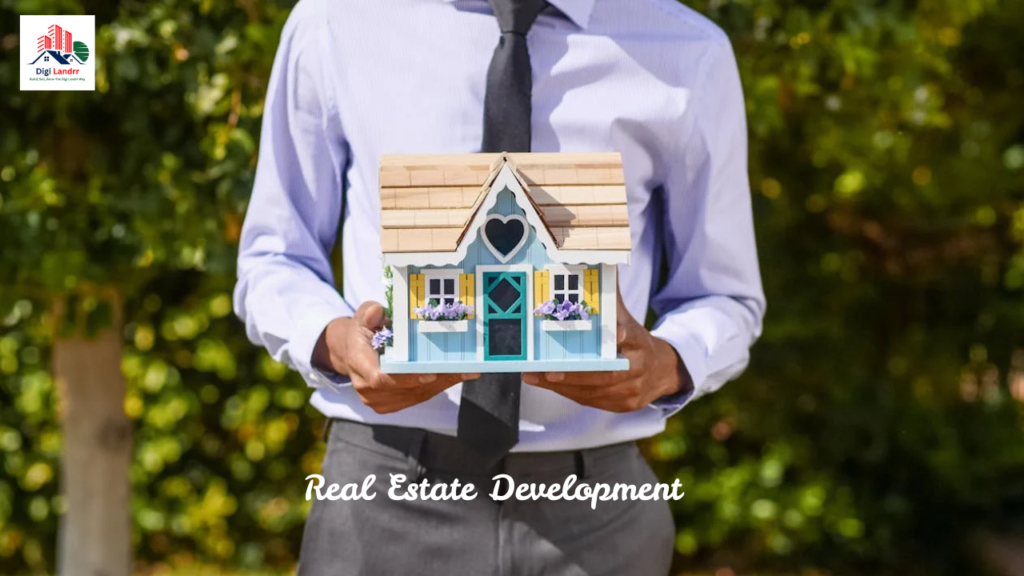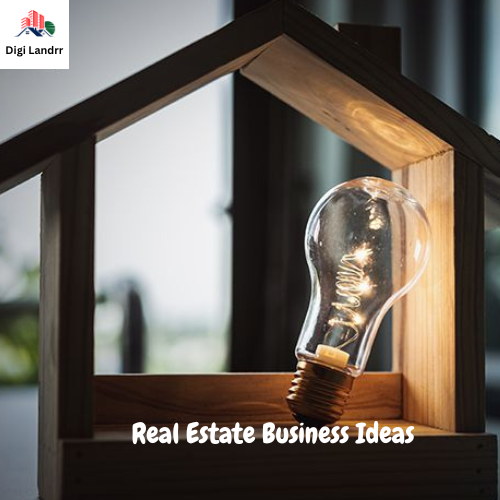Real Estate Business Ideas for Maximum Profit in 2025.
In 2025, the real estate industry continues to evolve, driven by technological advancements, changing consumer preferences, and innovative business models. Understanding the trends and tapping into lucrative niches is crucial for entrepreneurs and investors looking to maximize profit. At Digi Landrr, we specialize in helping businesses like yours navigate these opportunities with data-driven strategies and creative solutions. Here are the top No:-1 real estate business ideas for maximum profit in 2025.
The real estate industry is experiencing a transformative wave driven by technology, sustainability, and convenience. Smart home real estate development has emerged as a lucrative and forward-thinking sector, meeting the growing demand for properties equipped with advanced home automation systems, energy-efficient solutions, and cutting-edge security technologies.
A. Why Smart Home Real Estate Development is the Future
The real estate landscape is evolving rapidly as modern buyers prioritize convenience, efficiency, and security. Traditional homes, with their basic structures and minimal technological integration, no longer meet the expectations of today’s discerning homeowners. Smart home real estate development addresses these demands by offering a blend of technology, sustainability, and enhanced living experiences. Here’s an in-depth look at why smart homes are shaping the future of real estate:
1. Advanced Automation Systems: Revolutionizing Daily Living
Modern homeowners desire seamless control over their living environment, and advanced automation systems deliver precisely that.
Voice-Controlled Devices:
Voice assistants like Alexa, Google Home, and Siri have become staples in smart homes. These devices allow residents to:
- Adjust the thermostat for precise temperature control.
- Manage lighting by dimming, switching on/off, or even changing hues through voice commands.
- Operate entertainment systems, such as turning on the TV or selecting music playlists.
The convenience extends to tasks like creating reminders, answering questions, and integrating with other smart devices, making life more efficient and enjoyable.
Smart Appliances:
The kitchen and laundry room are seeing transformative innovations:
- Refrigerators: Equipped with internal cameras and inventory tracking, they notify users when items are low and can even suggest recipes based on available ingredients.
- Washing Machines: Many can be scheduled remotely via mobile apps, allowing users to start or stop cycles while they’re away.
- Ovens and Coffee Makers: Preheat your oven or brew your coffee automatically through smart programming, saving time and energy.
These appliances not only simplify household chores but also add a layer of personalization that was previously unthinkable.
2. Energy-Efficient Properties: Sustainability and Savings Combined
The global shift toward sustainability has propelled energy-efficient homes into the spotlight. Buyers are increasingly looking for properties that reduce environmental impact while offering significant cost savings.
Sustainability Meets Savings:
Smart homes are designed to consume energy responsibly:
- Smart Thermostats: Devices like Nest and Ecobee adjust heating and cooling based on the homeowner’s schedule and preferences. They also detect when no one is home and automatically conserve energy.
- Solar Panels: Renewable energy solutions reduce reliance on traditional power grids and slash electricity bills, offering long-term savings.
- LED Lighting: Long-lasting, energy-efficient bulbs lower utility costs while reducing waste.
Smart Energy Monitoring:
These systems take energy efficiency a step further by providing real-time insights into energy consumption patterns.
- Homeowners can identify energy-draining appliances and take corrective measures.
- Data-driven decisions, such as turning off unused devices, contribute to both savings and environmental benefits.
Energy-efficient properties appeal to eco-conscious buyers while offering developers an opportunity to market these homes as sustainable investments.

3. Enhanced Security Technologies: Peace of Mind for Homeowners
Safety is a top priority for homebuyers, and smart home technology has elevated security standards far beyond traditional locks and alarms.
Smart Surveillance Systems:
Security in smart homes begins with comprehensive surveillance:
- Video Doorbells: Devices like Ring allow homeowners to view and interact with visitors, even when they’re not at home.
- AI-Powered Cameras: These systems detect unusual activity, such as unfamiliar faces or movement in restricted areas, and notify homeowners instantly.
- Motion Detectors: Strategically placed sensors can identify unauthorized access and trigger alerts or alarms.
Biometric Access Control:
Replacing traditional keys, biometric systems use fingerprint and facial recognition for entry:
- Homeowners no longer need to worry about lost keys or unauthorized duplication.
- The system logs entry and exit data, adding a layer of accountability and transparency.
These technologies ensure robust protection while offering convenience, making them indispensable in modern smart homes.
The Bigger Picture: Why Smart Homes Resonate with Buyers
Smart homes go beyond technology—they align with evolving lifestyles and aspirations. They cater to:
- Tech-Savvy Individuals: Buyers who value cutting-edge solutions to improve daily living.
- Eco-Conscious Consumers: Those who prioritize sustainability and reducing their carbon footprint.
- Security-Minded Families: Homeowners seeking advanced, user-friendly protection for their loved ones.
# B:-Investing in Smart Homes: A Win-Win for Developers and Buyers
The global real estate landscape is shifting as technological advancements and environmental awareness reshape buyer preferences. Smart homes, with their integrated automation, energy-efficient solutions, and enhanced security features, are not just a passing trend—they are the future of real estate. For both developers and buyers, smart homes represent a transformative opportunity. Let’s explore in depth why investing in smart homes is a mutually beneficial decision.
1. Attracting High-Value Clients
Modern buyers demand more than just a house; they want a lifestyle tailored to their needs, and smart homes deliver on that promise.
Who are the High-Value Clients?
- Tech-Savvy Buyers: These individuals embrace technology and look for homes equipped with voice-controlled devices, automated systems, and smart appliances. They appreciate seamless integration and are willing to pay a premium for cutting-edge features.
- Young Professionals: The millennial and Gen Z workforce prioritizes convenience, sustainability, and tech-forward solutions. Smart homes appeal to their lifestyle, offering efficiency and status.
- Environmentally Conscious Individuals: Buyers who value eco-friendly living are drawn to energy-efficient features like smart thermostats, solar panels, and energy monitoring systems.
Why Are They Willing to Pay More?
Smart homes promise long-term savings, enhanced convenience, and personalized living experiences. For instance, a smart thermostat can significantly reduce utility bills, while integrated security systems offer peace of mind. The perceived value of these benefits encourages buyers to invest more upfront.
For developers, targeting these demographics ensures a steady stream of high-value clients, driving profitability and market relevance.
2. Future-Proofing Real Estate
The real estate market is constantly evolving, and homes with adaptable, tech-forward designs are better equipped to retain their value.
Technology Is Rapidly Advancing:
- The integration of Internet of Things (IoT) devices is becoming the standard in modern living.
- Features like AI-driven appliances, smart HVAC systems, and home automation hubs ensure homes remain relevant as technology evolves.
- Buyers are increasingly expecting homes that can integrate with future technologies, such as renewable energy solutions and advanced AI systems.
Why Does Future-Proofing Matter?
- Retaining Property Value: Smart homes equipped with scalable technologies are more likely to maintain or even increase their value over time. A home that can adapt to future trends remains desirable in the market.
- Meeting Long-Term Buyer Expectations: As technology advances, buyers will demand homes that align with the latest innovations. Properties that can accommodate these updates will remain competitive.
- Standing the Test of Time: Developers who build homes with future-proof systems ensure their properties don’t become obsolete in a rapidly changing market.
For developers, investing in smart home technologies is a long-term strategy that ensures enduring market relevance and buyer interest.

3. Strengthening Market Position
In an industry where competition is fierce, differentiation is key. Smart home real estate development positions developers as leaders in innovation and sustainability.
Why Does Innovation Matter?
- Buyers are drawn to forward-thinking developers who prioritize cutting-edge solutions.
- Offering smart features demonstrates a commitment to quality and modernity, setting the developer apart from competitors.
- Innovative designs and technologies contribute to positive branding and market reputation.
How Sustainability Enhances Positioning:
- Energy-efficient homes resonate with environmentally conscious buyers and investors.
- Incorporating sustainable materials, renewable energy solutions, and green certifications showcases a commitment to environmental responsibility.
- Developers who align their projects with sustainability trends are better equipped to attract institutional investments and partnerships.
Competing in a Saturated Market:
- Real estate markets are increasingly crowded, and standing out requires more than just attractive pricing.
- Developers who focus on delivering smart, sustainable homes not only cater to current demands but also anticipate future needs, ensuring continued success.
The Win-Win Scenario
Smart homes benefit everyone involved:
- For Buyers: They gain energy-efficient, convenient, and secure living spaces that align with their modern lifestyles. The upfront investment pays off in savings, improved quality of life, and long-term property value.
- For Developers: Smart home projects attract premium buyers, enhance market positioning, and future-proof their investments, ensuring profitability and sustainability.
# C:- The Features Buyers Look For in Smart Homes: A Comprehensive Guide
As the demand for smart homes grows, buyers become increasingly discerning about the features that enhance convenience, efficiency, and sustainability. Developers and real estate investors must understand these preferences to create homes that not only meet but exceed expectations. Here’s an in-depth look at the most sought-after features in smart homes and why they matter.
1. Integrated Home Hubs: The Command Center of Modern Living
An integrated home hub serves as the central brain of a smart home, seamlessly connecting and controlling various devices and systems.
What Buyers Expect:
- Centralized Control: A single interface (via smartphone, tablet, or wall-mounted panel) that manages everything from lighting and security to entertainment and climate control.
- Cross-Device Compatibility: Integration with popular ecosystems like Google Home, Amazon Alexa, or Apple HomeKit ensures compatibility with various devices.
- Intuitive Interfaces: Buyers prefer easy-to-use dashboards with voice-command capabilities for hassle-free operation.
Why It’s Important:
- Eliminates the need for multiple apps or remotes, simplifying the homeowner’s experience.
- Enhances convenience by enabling automation, such as turning on lights when entering a room or adjusting the thermostat based on occupancy.
- Future-proofs the home, as hubs can adapt to new devices and technologies.
Example in Action:
Imagine a buyer walking into a home and saying, “Good morning,” triggering the lights to brighten, the coffee machine to start, and the blinds to open. This level of integration is what makes a smart home truly appealing.
2. Smart HVAC Systems: Personalized Comfort with Energy Efficiency
Heating, ventilation, and air conditioning (HVAC) systems are crucial for both comfort and energy savings. Smart HVAC systems elevate the experience with automation and customization.
What Buyers Expect:
- Temperature Personalization: Automated systems that adjust temperature settings based on time of day, occupancy, or weather conditions.
- Remote Access: The ability to control the HVAC system from anywhere via smartphone apps.
- Energy Monitoring: Real-time insights into energy usage and suggestions for optimizing efficiency.
Why It’s Important:
- Comfort: Tailored climate control ensures that each room is comfortable for its occupants.
- Savings: Reducing energy waste translates to lower utility bills—a feature particularly appealing to eco-conscious buyers.
- Environmental Impact: Energy-efficient HVAC systems align with sustainable living goals, reducing the home’s carbon footprint.
Example in Action:
A family on vacation can set their HVAC system to “away mode,” ensuring minimal energy use while they’re gone and pre-programming it to return to their preferred settings upon their return.
3. Eco-Friendly Building Materials: Sustainability Meets Innovation
Smart homes are not just about advanced technology—they’re about creating sustainable living spaces. Eco-friendly materials play a key role in appealing to environmentally conscious buyers.
What Buyers Expect:
- Sustainable Construction: Use of recycled, renewable, or locally sourced materials.
- Energy-Efficient Insulation: Materials that reduce energy consumption by maintaining indoor temperatures.
- Low-VOC Finishes: Paints, adhesives, and finishes with low volatile organic compounds for healthier indoor air quality.
Why It’s Important:
- Long-Term Value: Homes built with durable and sustainable materials are seen as a wise investment.
- Health Benefits: Non-toxic materials contribute to better indoor air quality, promoting health and well-being.
- Environmental Responsibility: Buyers increasingly prioritize homes that minimize environmental impact, aligning with global sustainability goals.
Example in Action:
A home constructed with bamboo flooring, reclaimed wood accents, and energy-efficient insulation showcases both style and sustainability, appealing to a wide audience.

4. Customizable Options: Tailored Smart Living
Today’s buyers want homes that reflect their personal preferences, and customization in smart home features is a significant value-add.
What Buyers Expect:
- Personalized Automation: The ability to create unique routines, such as “movie mode,” which dims lights, lowers blinds, and adjusts the thermostat.
- Device Selection: Offering a choice of brands or models for devices like smart thermostats, cameras, or lighting systems.
- Scalable Systems: Buyers want the option to start with basic automation and expand as their needs grow.
Why It’s Important:
- Flexibility: Customizable features allow buyers to adapt their homes to their unique lifestyles.
- Appeal to a Broader Market: Tailored options attract a diverse range of buyers with varying preferences.
- Increased Perceived Value: Personalization enhances the emotional connection buyers feel toward the property, making them more likely to invest.
Example in Action:
A buyer can choose between preset automation packages (e.g., “Eco-Friendly Home,” “Luxury Living”) or create their own, mixing and matching features to suit their lifestyle.
How Developers Can Deliver on These Expectations
To successfully cater to modern buyers, developers should:
- Invest in Partnerships: Collaborate with tech companies to ensure the latest and most reliable smart home systems are included.
- Emphasize Education: Provide buyers with detailed guides or training on how to use their smart home features.
- Focus on Integration: Ensure all systems work seamlessly together, avoiding compatibility issues.
- Market the Benefits: Highlight the convenience, cost savings, and sustainability of smart home features in marketing materials.
# D;-Positioning Your Business as a Leader in Smart Home Real Estate Development
In an era where technology and sustainability converge, the smart home real estate sector presents an unparalleled opportunity for developers to set themselves apart. Positioning your business as a leader in this niche requires not only cutting-edge offerings but also a clear understanding of buyer needs and proactive strategies to showcase your expertise. Here’s a detailed guide to becoming a frontrunner in smart home real estate development.
1. Collaborate with Tech Companies: Harnessing Expertise and Innovation
To lead in smart home real estate, partnering with established technology providers is a strategic necessity.
Why Collaboration Matters:
- Access to the Latest Innovations: Leading tech companies are at the forefront of advancements in home automation, from AI-powered devices to energy-efficient systems. Partnering with these firms ensures your properties are equipped with state-of-the-art solutions.
- Seamless Integration: Collaboration helps address compatibility issues, creating a cohesive and user-friendly experience for buyers.
- Co-Branding Opportunities: Aligning your brand with reputable tech companies enhances your credibility and appeal.
Actionable Steps:
- Form Strategic Alliances: Partner with companies like Google, Amazon, or Apple for smart home ecosystems, or collaborate with niche providers specializing in solar panels, energy monitoring, or security systems.
- Joint Product Development: Work with tech partners to create exclusive smart home packages tailored to your properties.
- Stay Updated: Regularly engage with tech companies to stay informed about upcoming innovations and integrate them into your projects.
Example in Action:
A real estate developer could partner with Tesla to offer homes with integrated Tesla solar roofs and Powerwalls, emphasizing sustainability and cutting-edge energy solutions.
2. Educate Buyers: Building Trust Through Knowledge and Transparency
For many potential buyers, smart home technology can seem complex or unfamiliar. Educating your audience not only builds trust but also positions your brand as a helpful and forward-thinking leader.
Why Buyer Education is Crucial:
- Demystifying Technology: Providing clear and accessible information reduces buyer hesitation and enhances confidence in your offerings.
- Showcasing Benefits: Highlighting real-life applications and lifestyle improvements makes the value of smart features tangible.
- Building Excitement: Engaging demonstrations can generate enthusiasm and position your homes as aspirational living spaces.
Actionable Steps:
- Host Demonstrations: Organize open houses with live demonstrations of integrated home automation systems. Allow buyers to experience voice-controlled lighting, automated temperature adjustments, and security features firsthand.
- Create Educational Content: Develop brochures, videos, or online guides explaining how smart home technology works and its benefits, including cost savings, convenience, and sustainability.
- Offer Personalized Walkthroughs: Provide potential buyers with one-on-one sessions to explore the features most relevant to their needs.
Example in Action:
A smart home tour could feature interactive stations where visitors control lighting through a mobile app, view live footage from security cameras, and adjust the thermostat with voice commands—all while learning about the energy savings these features deliver.
3. Highlight ROI: The Dual Appeal of Cost Savings and Enhanced Lifestyles
Smart homes are not just about convenience—they are investments that offer long-term returns in the form of energy savings and increased property value.
Why ROI Matters:
- Appealing to Pragmatic Buyers: While many buyers are excited by the novelty of smart homes, others are motivated by tangible benefits like reduced utility bills and long-term value.
- Differentiating Your Offerings: Highlighting financial and lifestyle returns positions your homes as a smart choice for both luxury and practicality.
Actionable Steps:
- Showcase Energy Savings: Use data to demonstrate how features like smart thermostats, energy-efficient appliances, and solar panels reduce monthly utility costs.
- Promote Resale Value: Emphasize how smart homes remain desirable in the real estate market, ensuring strong resale potential.
- Highlight Lifestyle Enhancements: Beyond financial ROI, underline how automation and sustainability improve daily living, from added security to tailored comfort.
Example in Action:
Market a smart home as a “future-ready investment,” showing projections of potential savings over five years and comparing these to traditional homes. Include testimonials from homeowners who’ve experienced these benefits firsthand.
4. Strengthening Your Market Position: Stand Out as an Industry Leader
A strong reputation for innovation and buyer-centric offerings is key to staying ahead in a competitive market.
Why Market Position is Key:
- Building Brand Recognition: Establishing your name as synonymous with smart home excellence attracts high-value clients.
- Creating Buyer Loyalty: Offering exceptional experiences encourages word-of-mouth referrals and repeat business.
- Driving Long-Term Growth: A strong position in the smart home niche ensures resilience against market fluctuations.
Actionable Steps:
- Leverage Social Proof: Use reviews, testimonials, and case studies to build trust and demonstrate success.
- Invest in Branding: Develop a brand identity that reflects your commitment to innovation, sustainability, and buyer satisfaction.
- Engage in Thought Leadership: Publish articles, host webinars, or participate in industry conferences to establish yourself as a smart home expert.
Example in Action:
Position your brand as a thought leader by sharing insights on upcoming smart home trends through blogs, social media, and partnerships with industry publications.
5. Leveraging Marketing Channels: Reaching the Right Audience
To maximize your visibility and attract the right buyers, it’s essential to use targeted marketing strategies.
Actionable Steps:
- Digital Campaigns: Run targeted ads highlighting the benefits of your smart homes, focusing on tech-savvy buyers and environmentally conscious families.
- Social Media Engagement: Use platforms like Instagram and LinkedIn to share videos, testimonials, and behind-the-scenes content.
- Community Events: Host workshops or seminars on smart living to engage with local communities and showcase your projects.


